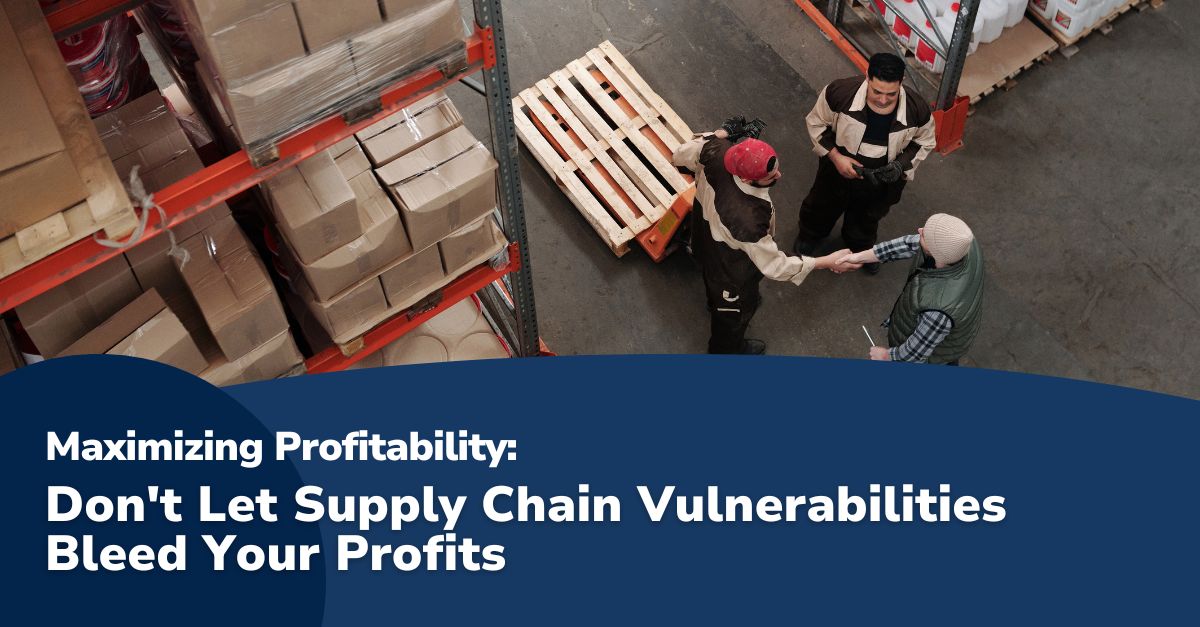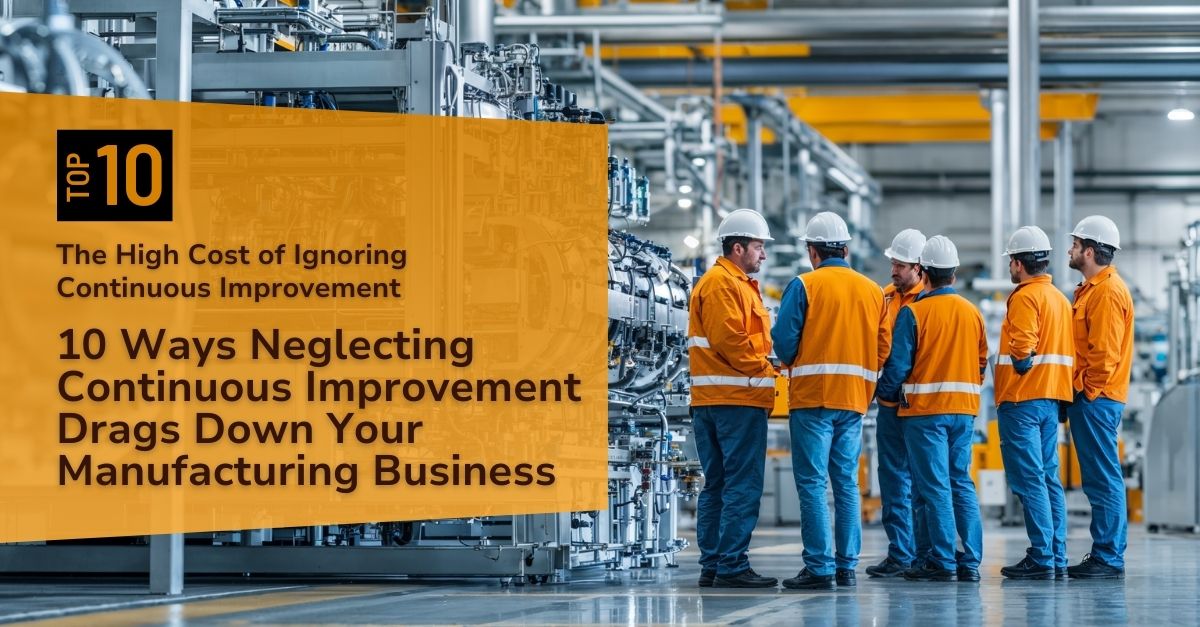
In manufacturing, your supply chain is more than a background process. It is the lifeline that keeps raw materials flowing, production schedules on track, and customer orders fulfilled.
When that chain breaks or slows, the entire operation feels the impact. The result is not just short-term inconvenience. Disruptions can create a cascade of higher costs, lost revenue, quality compromises, and long-term damage to your brand.
Today’s supply chain risks are broader and more unpredictable than ever.
Geopolitical tensions, natural disasters, labor strikes, port closures, sudden demand swings, and material shortages can all strike with little warning. The reality is that these events are not going away. What matters is how well your business can anticipate, respond, and adapt when they occur.
Below are the 10 most common ways supply chain disruptions hurt profitability, along with targeted steps you can take to reduce risk and recover faster when challenges arise.
1Geopolitical Risk:
Unstable trade relationships, tariffs, sanctions, and regional conflicts can shut down the flow of materials almost overnight. For example, a supplier in a politically volatile region might suddenly face export restrictions, leaving your production lines without a critical component. The more concentrated your sourcing is in one area, the greater the impact.
What to do: Spread sourcing across multiple stable regions with favorable trade conditions. Monitor developments through reliable industry and geopolitical news sources. Keep alternative suppliers vetted and ready so you can switch quickly if necessary.
2Production Delays:
Late arrivals of key parts or raw materials can idle equipment, stall assembly lines, and cause missed customer deadlines. Even a delay of a few days can create a backlog that takes weeks to clear.
What to do: Use real-time shipment tracking and predictive analytics to spot potential delays before they cause stoppages. Build flexibility into your production schedule so you can adjust work sequences and keep lines running.
3Stockouts and Lost Sales:
A stockout is more than a lost sale. It is a lost opportunity to keep a customer loyal. If buyers turn to a competitor because you cannot deliver, they may not return. This is especially damaging when lead times are long, and customers cannot wait for restocks.
What to do: Improve demand forecasting by combining historical sales data with market trend analysis. Position critical inventory closer to your largest markets and maintain an emergency reserve for high-demand products.
4Increased Inventory Costs :
In an attempt to avoid shortages, some companies overcompensate by stockpiling excess materials. This ties up working capital, raises storage costs, and increases the risk of spoilage, obsolescence, or damage.
What to do: Use inventory optimization software to balance availability with cost control. Share your production and sales forecasts with suppliers so they can align production and delivery to your needs, reducing the pressure to hold excess stock.
5Expedited Shipping Costs:
When parts arrive late, many companies turn to premium freight services to recover time. While this might save a deadline, the added shipping cost can wipe out the profit from the order.
What to do: Negotiate priority shipping rates with carriers before you need them. Maintain a buffer in your production schedule to reduce the need for expensive last-minute shipments.
6Product Quality Issues:
Switching to an unfamiliar supplier to fill a gap, or rushing production to catch up, can lead to defects and rework. Poor-quality materials or workmanship can trigger warranty claims, product recalls, and customer complaints.
What to do: Maintain a list of backup suppliers who meet your quality standards. Keep quality checks consistent, even in emergencies. Schedule periodic audits for both primary and backup suppliers.
7Customer Dissatisfaction:
Late deliveries, partial shipments, or cancelled orders damage customer confidence. Once trust is broken, it is difficult and costly to win it back.
What to do: Communicate with customers before they have to ask for updates. Offer alternatives when delays occur, such as substitute products, partial shipments, or direct-from-supplier fulfillment when possible.
8Reputation Damage:
A supply chain that repeatedly fails to deliver can brand your business as unreliable. This can hurt sales, make negotiations with new customers more difficult, and even limit your ability to win contracts.
What to do: Map your entire supply chain to identify vulnerabilities. Diversify sourcing, build redundancy, and invest in systems that allow you to respond quickly and transparently to disruptions.
9Damaged Supplier Relationships:
Frequent last-minute changes, expedited demands, or shifting requirements strain relationships with suppliers. Over time, this can lead to less favorable terms, longer lead times, or lower priority during high-demand periods.
What to do: Treat suppliers as strategic partners rather than transactional vendors. Share forecasts, plan collaboratively, and recognize when they step up in difficult situations.
10Inefficient Processes and Lack of Agility:
Outdated manual processes, siloed communication, and limited visibility make it harder to adapt when disruptions happen. This slows response times and increases errors.
What to do: Invest in modern supply chain management systems with real-time data visibility. Review workflows regularly to eliminate bottlenecks and train teams to collaborate across departments when rapid adjustments are needed.
Your Roadmap to Unstoppable Profitability
The harsh reality is that supply chain disruptions are here to stay. However, their impact on your profitability doesn’t have to be devastating. By understanding the vulnerabilities we’ve discussed – from over-reliance on single suppliers to inefficient processes – you can take proactive steps to protect your business from costly consequences.
Investing in supply chain visibility, technology solutions, proactive planning, and strong supplier relationships might now seem like an additional expense.
Remember, these investments will pay off exponentially during the next inevitable disruption. The difference between a crisis that derails your profits and a challenge you navigate with resilience lies in your actions today.
Partnering with POWERS
Strengthening your supply chain is not just about avoiding disruptions. It is about creating a system that can adapt to change, protect profitability, and sustain growth over the long term. As a management consultant specializing in manufacturing performance, POWERS works with clients to identify vulnerabilities, optimize supplier relationships, and improve operational agility.
- Risk Assessment and Mitigation: We'll thoroughly analyze your supply chain to identify potential vulnerabilities, create contingency plans, and implement proactive strategies to minimize disruption risks.
- Supplier Network Optimization: We help you diversify your supplier base, develop strategic sourcing plans, and build strong relationships with reliable, high-quality suppliers.
- Technology Integration: We'll recommend and implement cutting-edge supply chain visibility tools and data analytics platforms to provide real-time insights and enhance decision-making.
- Process Improvement: From demand forecasting to inventory management, we'll identify opportunities for streamlining processes, boosting efficiency, and reducing operating costs.
Our DPS platform gives you the real-time data and visibility needed to make faster, better-informed decisions, whether it is tracking shipments, monitoring supplier performance, or adjusting production plans on the fly. Combined with our hands-on consulting expertise, you gain both the insight and the execution support to keep your operation running smoothly — even when challenges arise.
Take the first step towards a more resilient and profitable future. Contact POWERS today to discover how our expertise can help you optimize your manufacturing processes and achieve unprecedented levels of efficiency. Connect with us at +1 678-971-4711 or via email at info@thepowerscompany.com.
Continue Reading from this Mastery Series
- Part 1 - How Runaway Costs Derail Manufacturers’ Drive for Sustainability
- Part 2 - Tackling Excessive Waste Management Issues in Manufacturing
- Part 3 - Mastering Resource Efficiency in the Quest for Manufacturing Excellence
- Part 4 - The Impact of Unmitigated High Energy Costs on Manufacturers
- Part 5 - How the Complexities of Regulatory Compliance Can Erode Margins
- Part 6 - Navigating the Challenges of Reduced Market Competitiveness for Sustained Profitability
- Part 7 - Don’t Let Preferences Pull You Under
- Part 8 - Low Talent Investment is Undermining Your Bottom Line
- Part 9 - Don’t Let Supply Chain Vulnerabilities Bleed Your Profits
- Part 10 - Outsmart the Competition and Protect Your Profits







